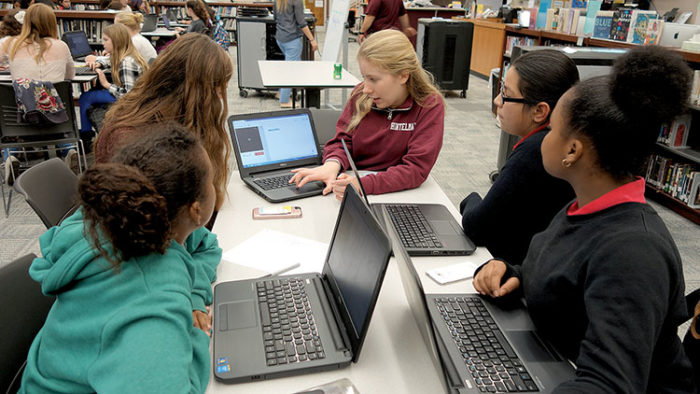
LITTLE SILVER – Like many schools across the county and the nation, Red Bank Regional High School (RBR) recognizes the importance of science, technology, engineering and math (STEM) programs in their curriculum.
RBR even runs a state-certified academy program in both Information Technology (AOIT) and Engineering (AOE) which students from all over Monmouth County attend. The AOIT has also developed a specialty in cybersecurity yielding many regional, state and national accolades.
Yet even with programs like these growing around the country, engineering and computer technology still fail to attract an equal number of females as males to their ranks, with the RBR programs reflecting this gender disparity. Currently, only 23 percent of the 92 students in the Academy of Engineering are girls. That number is even lower in the Academy of Information Technology: only 15 percent of the 102 students in that program are female.
The teachers in the academies have tried to address this gap in the past. Several years ago, AOIT teachers Mandy Galante and Jeremy Milonas made an appeal to the RBR sending districts (Red Bank, Little Silver and Shrewsbury) and were able to field a team to enter the national CyberPatriot competition. The results were outstanding, as two teams from Markham Place School in Little Silver won first and third place in the Middle School Division. One team was composed of girls and boys; a second was an all-girls team.
And this year, using a grant from the RBR BUC Backer Foundation, Alison Murphy, a math and AOIT teacher, with the help of AOIT teacher Jeremy Milonas, developed the “Girls Who Code” program to get fifth through eighth grade girls interested in engineering and computer fields before they enter high school. The program began in October and continues through May with monthly meetings. Over 30 students have attended each session.
The middle school girls are divided into smaller groups and work with one or two RBR high school students who guide them through exercises under the direction of Murphy and Milonas. The teachers and students volunteer their time to the program. Expenses, including the cost of coding robots, T-shirts, certificates and dinner are funded from the BUC Backer grant.
“We thought that getting them to experience STEM at an earlier age and with their friends would encourage more to go into these fields,” said Murphy.
She describes the code work in which the girls are engaged as a variety of mostly block languages, including Scratch and Blockly. The work is inherently fun, with the students using Lego robots and Ozobots and creating apps through App Inventor.
“The girls will also be learning a little bit of binary language and how a computer works,” Murphy said. “We may introduce them to HTML, Python or Java, depending on how the sessions go. The main focus is to generate interest in computer science and enlighten them on the possibilities and opportunities that computer science can provide.”
The girls were also introduced to engineering through the 3-D printer in engineering and math teacher Ashley Studd’s classroom. There the students examined animal-shaped cookie cutters being produced by the machine.
Getting more women interested in these fields is not just a benefit for females, but for the country as well. According to Code.org, just in the state of New Jersey there are 22,365 open computing jobs and only 1,111 computer science graduates, leaving many well-paying jobs unfilled.
“I volunteered because I wanted to get more kids involved,” said Corine Normandin of Brielle, one of the RBR AOIT student volunteers. “I feel it is a career field that needs a lot of girls and this is a great way to do it. I think the program is going very well as they are having fun, are engaged and are getting the idea that this is very interesting and it is getting them excited about coding,” she added.
Red Bank Middle School eighth grader Jennifer Hernandez found the program very interesting and fun.
“This program is in a new form from what I learned in the past,” she said. “It is really fun and I am planning on doing either technology or engineering in high school next year. Before this I was thinking of another academy but after doing this program I feel more connected to RBR.”
The program will be evaluated throughout the year based on the accomplishments the students achieve in programming through their activities, and, ultimately, on how many new female students the program attracts to the technical academies at RBR over the next few years.


